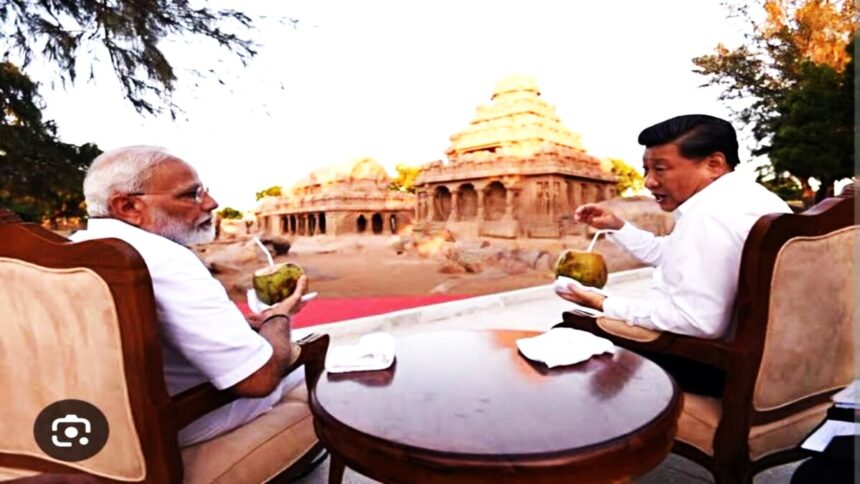After a prolonged standoff lasting over four years, there are encouraging signs that the longstanding border dispute between India and China may finally be approaching a resolution. As the BRICS conference in Kazan, Russia, on October 22-23 draws near, expectations are mounting that Indian Prime Minister Narendra Modi and Chinese President Xi Jinping could engage in discussions aimed at easing tensions.
A Longstanding Stalemate
The deadlock in the eastern Ladakh region has persisted since May 2020, following a violent clash that resulted in the deaths of 20 Indian soldiers and an unknown number of Chinese casualties. This confrontation marked a significant deterioration in relations between the two nations, which had historically navigated their differences with a degree of diplomatic finesse.
Foreign Secretary Vikram Misri recently indicated that both nations are nearing a consensus on resolving the border issue. Should an agreement be reached, it could effectively restore the pre-May 2020 status quo, a scenario that many in both countries view as highly desirable.
Potential Breakthrough Before BRICS
The upcoming BRICS summit is being closely monitored as a potential turning point in the India-China relationship. The summit will gather leaders from Brazil, Russia, India, China, and South Africa, and provides a unique platform for dialogue. Modi and Jinping’s potential meeting could serve as a crucial moment for diplomacy, signaling a willingness from both sides to move past the impasse that has defined their interactions for years.
India and China have reached an agreement to end the border crisis. 🇮🇳🇨🇳 #BRICS2024
China backs down. The armies of the two sides are locked in a standoff since April 2020
S JAISHANKAR : "We will be able to resume 2020-style patrolling along the Line of Actual Control (LAC)… pic.twitter.com/9UpJTCAOUH
— Vande Bharat 🇮🇳 🚩 (@Hindu_Samwad) October 21, 2024Steps Taken by India in Response to Tensions
In the wake of the border clashes, India has implemented a series of measures aimed at curbing Chinese influence and protecting national interests. These steps have not only underscored India’s commitment to safeguarding its sovereignty but have also reshaped the economic landscape between the two countries.
Ban on Direct Flights
One of the first major actions taken by India was the suspension of direct flights to and from China. For the past four years, travelers from China have had to rely on connecting flights, a move that has disrupted both business and tourism. Despite China’s repeated requests to restore direct passenger services, India has remained firm in its decision, citing security concerns.
Strict Visa Regulations
Alongside the flight ban, India tightened its visa application processes for Chinese nationals. This increase in scrutiny has made it significantly more challenging for Chinese engineers and professionals to obtain the necessary permissions to work in India. This step reflects India’s broader strategy of protecting its job market and safeguarding sensitive sectors from potential Chinese influence.
Clampdown on Chinese Investments
In 2020, India introduced stringent regulations that added layers of vetting and security checks for investments coming from neighboring countries, with a specific focus on Chinese companies. This has resulted in the stalling of numerous proposed investments amounting to billions of dollars. The message is clear: India is determined to prevent any acquisitions that could pose risks to national security.
Ban on Mobile Apps
India also took a bold step by banning approximately 300 Chinese mobile applications, citing concerns over data privacy and security. This move was part of a broader initiative to reduce dependence on Chinese technology and promote domestic alternatives. Moreover, legal actions against major Chinese firms like Vivo and Xiaomi for alleged violations have further strained economic ties, with significant assets being seized as part of investigations.
BRICS Summit and Beyond
The BRICS summit in Kazan is poised to be a significant moment for both India and China. Although there is currently no official confirmation of a bilateral meeting between Modi and Jinping, the possibility of dialogue looms large. Both leaders may see this as an opportunity to address the contentious border issue and work toward a more stable relationship.
Resolving the border dispute would not only ease military tensions but could also pave the way for improved economic cooperation between the two nations. As global dynamics continue to shift, both countries will need to navigate their relationship carefully to foster peace and stability in the region.
A Path Forward
As the world watches closely, the potential for a thaw in India-China relations is becoming increasingly tangible. The BRICS summit may serve as a platform for meaningful discussions, with the hope that leaders on both sides are willing to put aside past grievances for the greater good.
In a world where geopolitical tensions are on the rise, the resolution of the India-China border dispute could serve as a vital example of how diplomacy can triumph over discord. Whether this pivotal moment leads to lasting change remains to be seen, but the current developments offer a glimmer of hope for a more peaceful and cooperative future.
Read More : Empowering Jammu: Omar Abdullah’s Bold Choice of Surinder Kumar Choudhary as Deputy Chief Minister






